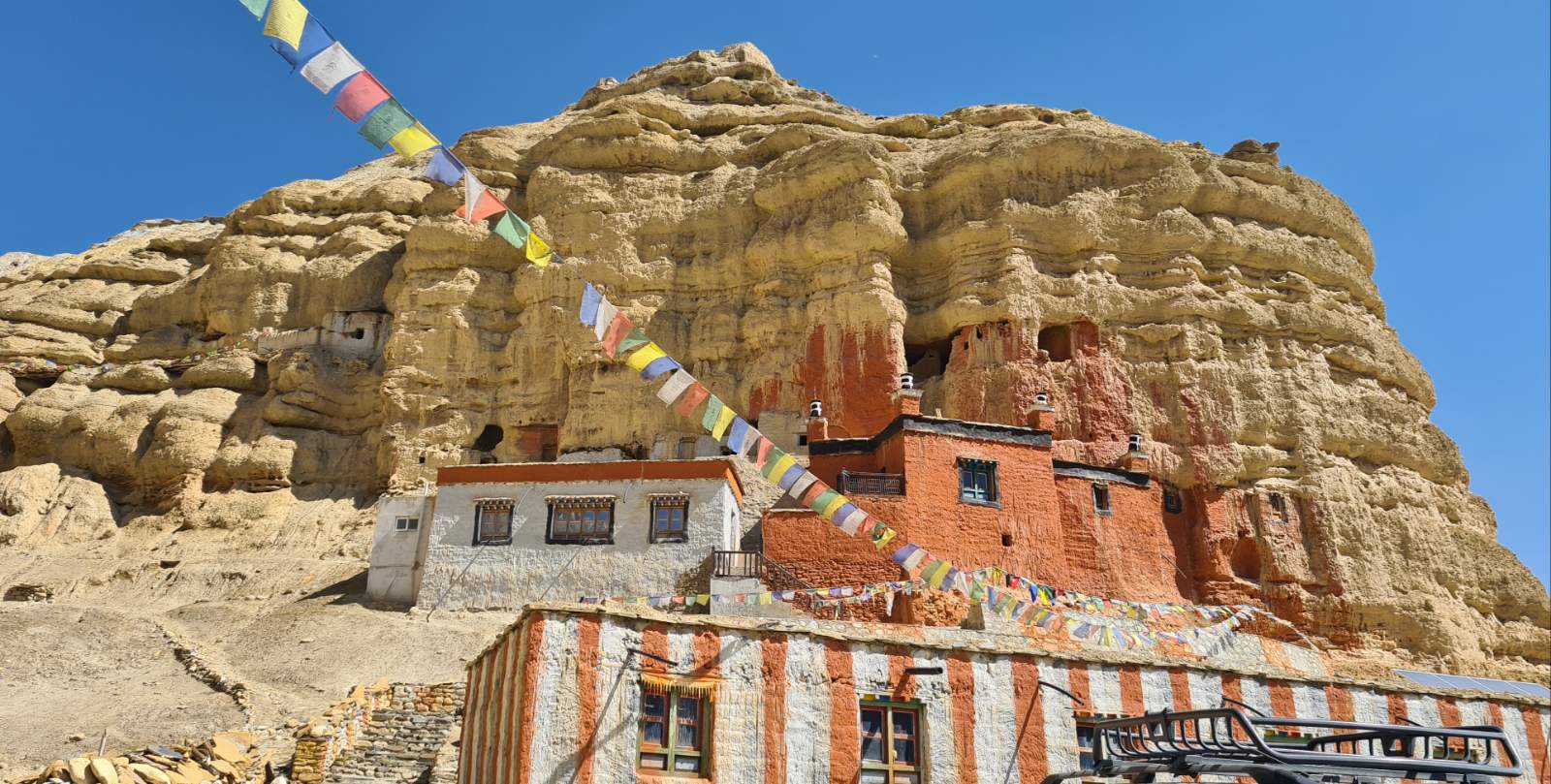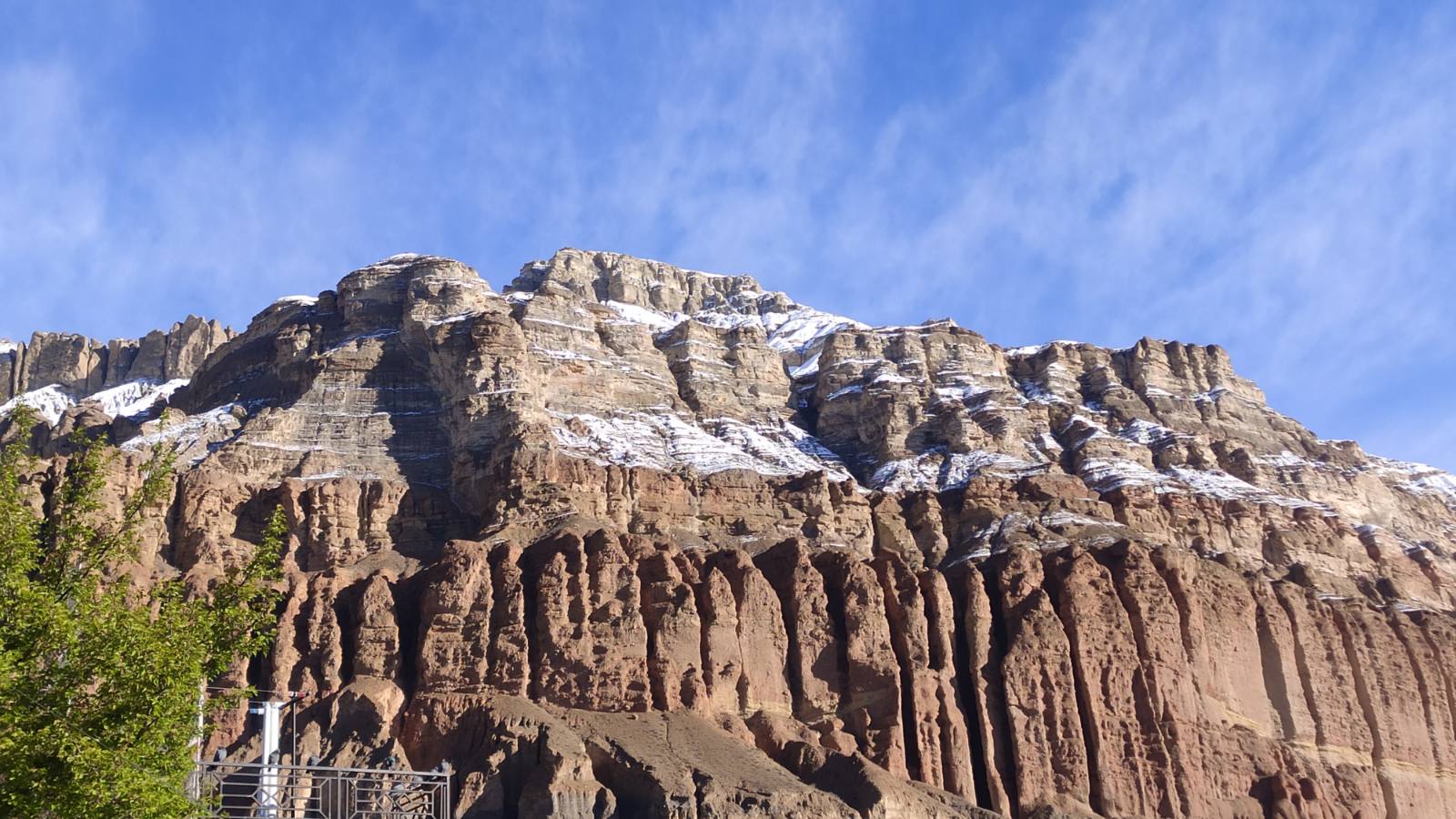Upper Mustang Trek
The Upper Mustang Trek takes you to the northernmost part of Nepal, bordering Tibet, and encompasses the ancient kingdom of Lo. Previously a restricted area, Upper Mustang was opened to foreign visitors only in 1992, allowing a limited number of trekkers to explore its hidden treasures. This region still preserves the remnants of the ancient Tibetan culture, making it a remarkable destination for cultural enthusiasts. The trek starts from Jomsom, a gateway to the Mustang region, and follows the Kali Gandaki River gorge, renowned for its impressive rock formations and the deepest gorge in the world.
Upper Mustang is often referred to as the “Last Forbidden Kingdom” due to its isolation and its preservation of traditional Tibetan culture. As you trek through the region, you will encounter ancient monasteries, cave dwellings, and historic forts, which serve as a testament to the rich history of this area. The capital city of Lo Manthang is a major highlight, with its walled city, narrow alleys, and the iconic four-story royal palace. The local people, known as Lo Tibetans, are warm and welcoming, and their unique lifestyle and vibrant festivals add a captivating charm to the trekking experience.
The Upper Mustang region is renowned for its stunning landscapes, characterized by arid desert-like terrain, colorful rock formations, and towering cliffs. The trail takes you through deep canyons and high passes, offering panoramic views of snow-capped peaks, including Nilgiri, Annapurna, and Dhaulagiri. As you traverse the mesmerizing landscapes, you will come across the picturesque villages of Kagbeni, Samar, and Ghami, where you can witness the traditional mud-brick houses and terraced fields that dot the rugged terrain.
One of the unique aspects of the Upper Mustang Trek is the opportunity to witness the centuries-old Tiji festival, which is celebrated annually in Lo Manthang. This vibrant three-day festival showcases traditional dances, colorful costumes, and ancient rituals, providing a captivating glimpse into the region’s religious and cultural practices. The trek also allows you to interact with the local people, learn about their traditional lifestyle, and savor the flavors of Tibetan cuisine, making for an immersive cultural experience.
The Upper Mustang Trek is a moderate-level trek, suitable for both seasoned trekkers and adventure enthusiasts with some prior experience. Permits are required to enter the Upper Mustang region, and it is advisable to trek with a licensed guide who can provide insights into the culture and history of the area. The best time to undertake this trek is during the spring and autumn seasons, when the weather is favorable and the landscapes come alive with blooming flowers and clear mountain views. The Upper Mustang Trek offers a truly off-the-beaten-path adventure, where you can explore a hidden kingdom, immerse yourself in a unique culture, and witness some of the most breathtaking landscapes in the Himalayas.
Route
-
Day 1: Arrival in Kathmandu
Upon your arrival in Kathmandu, you will be greeted by a representative and transferred to your hotel. Take the rest of the day to relax and explore the vibrant capital city.Day 2: Kathmandu to Pokhara
Take a scenic flight from Kathmandu to Pokhara, where you can enjoy the stunning views of the Himalayas and the picturesque lakeside city. Spend the day exploring Pokhara and preparing for the trek.Day 3: Pokhara to Jomsom (2,700m) and Trek to Kagbeni (2,810m)
Fly from Pokhara to Jomsom, a gateway to the Mustang region. From Jomsom, begin your trek to Kagbeni, a charming village situated at the confluence of the Kali Gandaki and Jhong Rivers. Overnight stay in Kagbeni.Day 4: Kagbeni to Chele (3,050m)
Start your trek towards Chele, following the Kali Gandaki River. Trek through the scenic landscapes, passing by ancient Tibetan-style villages and colorful cliffs. Reach Chele and spend the night at a teahouse.Day 5: Chele to Syanboche (3,475m)
Continue your trek, ascending to Syanboche. Enjoy the stunning views of the surrounding mountains and valleys as you pass through the rugged terrain. Overnight stay in Syanboche.Day 6: Syanboche to Ghemi (3,520m)
Trek through the beautiful landscapes, crossing several passes and descending into the village of Ghemi. Explore the traditional mud-brick houses and interact with the friendly locals. Overnight stay in Ghemi.Day 7: Ghemi to Tsarang (3,620m)
Resume your trek to Tsarang, passing through arid landscapes and ancient settlements. Visit Tsarang Monastery, which is one of the oldest monasteries in Mustang. Spend the night in Tsarang.Day 8: Tsarang to Lo Manthang (3,840m)
Embark on the final leg of your trek to Lo Manthang, the capital city of Mustang. Enter the walled city and explore its narrow alleys, ancient monasteries, and the royal palace. Overnight stay in Lo Manthang.Day 9-10: Explore Lo Manthang
Take a couple of days to immerse yourself in the rich cultural heritage of Lo Manthang. Visit monasteries, interact with the locals, and witness the unique lifestyle of the people. If your trek coincides with the Tiji festival, you can witness the colorful celebrations.Day 11: Lo Manthang to Dhakmar (3,820m)
Begin your return journey as you trek from Lo Manthang to Dhakmar. Enjoy the scenic landscapes and the unique rock formations along the way. Overnight stay in Dhakmar.Day 12: Dhakmar to Ghiling (3,570m)
Continue your descent to Ghiling, passing through picturesque villages and enjoying the views of the Mustang region. Overnight stay in Ghiling.Day 13: Ghiling to Chhuksang (2,980m)
Trek back to Chhuksang, retracing your steps through the Kali Gandaki River valley. Enjoy the last views of the Mustang landscapes. Overnight stay in Chhuksang.Day 14: Chhuksang to Jomsom (2,700m)
Conclude your trek as you make your way back to Jomsom. Celebrate the completion of the trek with your fellow trekkers.Day 15: Jomsom to Pokhara Take a morning flight from Jomsom to Pokhara.
Upon arrival, transfer to your hotel in Pokhara. Spend the rest of the day at leisure, relaxing and exploring the lakeside city.Day 16: Pokhara to Kathmandu After breakfast, take a scenic flight or drive back to Kathmandu. Once you reach Kathmandu, check into your hotel and spend the day at your leisure. You can explore the vibrant streets of Thamel, visit cultural sites, or indulge in some last-minute shopping.
Day 17: Departure from Kathmandu It’s time to bid farewell to the beautiful country of Nepal. After breakfast, you will be transferred to the airport for your onward journey or departure flight.
Vollpension
Die Kosten beinhalten:
Im Preis inbegriffen sind:
BC-Dienst
Die Kosten beinhalten:
Im Preis inbegriffen sind:
Price per person
Usefull Information
Inclusions:
- Accommodation (tea house or camping)
- Meals (breakfast, lunch, and dinner)
- Local transportation (airport transfer, trekking transportation)
- Trekking guide and porter services
- Necessary permits and fees
Exclusions:
- International airfare
- Travel insurance
- Personal expenses (alcohol, snacks, souvenirs, etc.)
- Tips for guide and porter
- Emergency evacuation expenses
- Any other expenses not mentioned in the inclusions list.
Usefull Information
- Clothing:
- Lightweight, quick-drying trekking pants
- Long-sleeved shirts (synthetic material is preferable)
- T-shirts (synthetic material is preferable)
- Fleece jacket or down jacket for colder temperatures
- Waterproof and breathable outer shell jacket
- Waterproof and breathable trekking pants or rain pants
- Thermal base layers (tops and bottoms) for colder temperatures
- Underwear and socks (moisture-wicking and quick-drying material)
- Sun hat and beanie/hat for cold weather
- Lightweight gloves and thermal gloves for higher altitudes
- Footwear:
- Sturdy trekking boots with ankle support and a good grip
- Lightweight trekking shoes or sandals for campsite or lower elevation walks
- Moisture-wicking and cushioned hiking socks
- Trekking Gear:
- Backpack (30-40 liters) with a rain cover
- Sleeping bag suitable for colder temperatures (depending on the trek)
- Trekking poles for better stability and balance
- Headlamp or flashlight with spare batteries
- Sunglasses with UV protection and a strap to secure them
- Water bottle or hydration bladder (at least 2 liters capacity)
- Water purification tablets or water filter
- Lightweight and quick-drying towel
- Personal toiletries (toothbrush, toothpaste, biodegradable soap, etc.)
- Protection from the Elements:
- Sunscreen with a high SPF rating
- Lip balm with SPF protection
- Insect repellent
- Hat or buff to protect your face and neck from the sun
- Lightweight and compact umbrella (optional)
- First Aid Kit:
- Basic first aid supplies (band-aids, adhesive tape, antiseptic wipes, etc.)
- Prescription medications (if necessary)
- Diamox (for altitude sickness, consult your doctor before taking it)
- Painkillers, such as ibuprofen or paracetamol
- Blister treatment (moleskin or blister plasters)
- Anti-diarrheal medication
- Oral rehydration salts
- Miscellaneous:
- Trekking map and guidebook
- Portable charger or power bank for electronic devices
- Camera or smartphone for capturing memories
- Lightweight and quick-drying travel towel
- Trekking permits and necessary documents









Leave a Reply